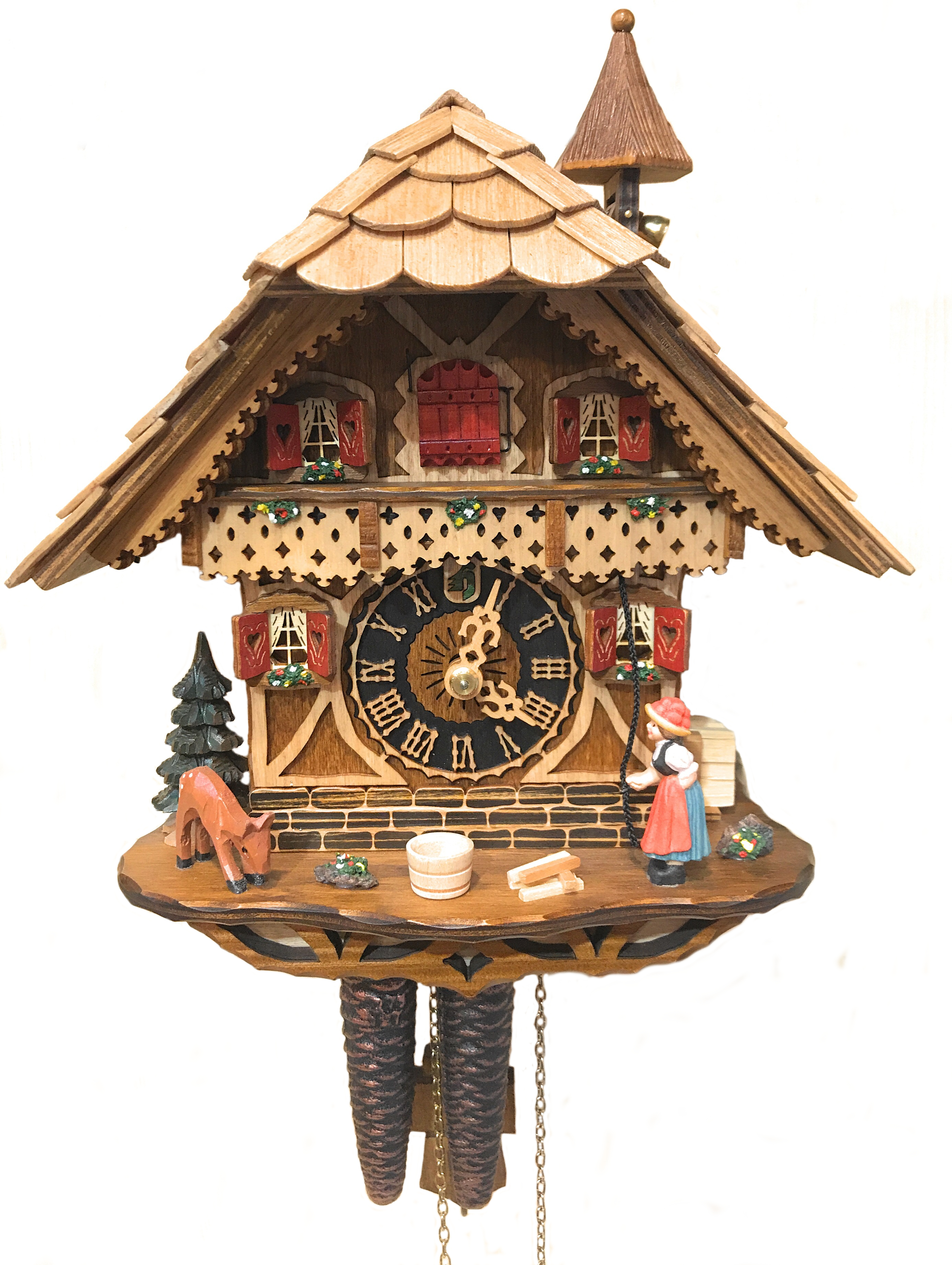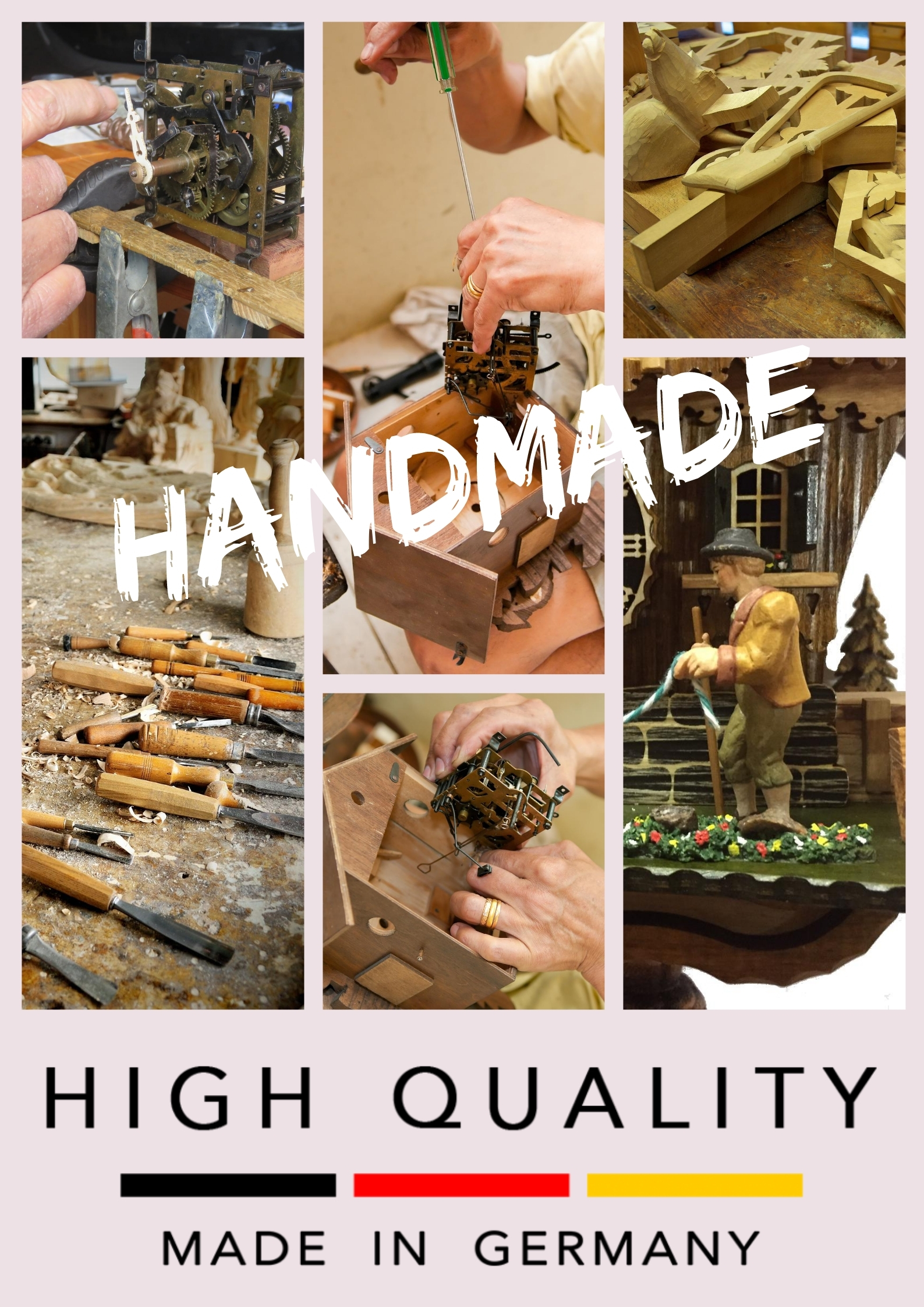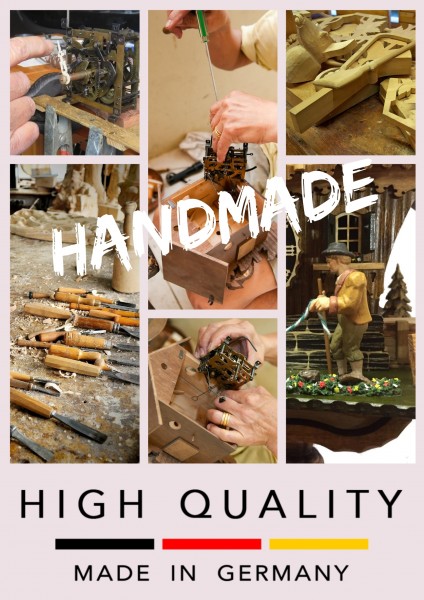Cuckoo Clock - What you should know!
For over 300 years now, in the region known as the Black Forest, or Schwarzwald in the southwestern part of Germany, they have been crafting the handmade cuckoo clocks. Although much has changed since the 18th century, very little about how a cuckoo clock works have changed. Clockmakers and Woodcarvers (sadly a trade that is dying) have preserved the art of handmade cuckoo clocks using the same mechanisms for many years to produce the classic cuckoo call.
The legend that keeps being told over and over again is that the cuckoo clock was invented by a clever Black Forest mechanic in 1730 by a man named Franz Anton Ketterer.
Why was the cuckoo clock invented? / Where did cuckoo clocks originate?
 The Black Forest people lived from farming and had very long winters so they started carving in the winter months, creating the wildlife seen most often on a cuckoo clock. The industry started and so it developed and still as up till today, come up with new designs and technical improvements which have made the cuckoo clock a valued work of art all over the world. This is also why the cuckoo clock history is linked to the Black Forest.
The Black Forest people lived from farming and had very long winters so they started carving in the winter months, creating the wildlife seen most often on a cuckoo clock. The industry started and so it developed and still as up till today, come up with new designs and technical improvements which have made the cuckoo clock a valued work of art all over the world. This is also why the cuckoo clock history is linked to the Black Forest.
The functionality of the cuckoo clock mechanism has remained basically unchanged, with some improvements here and there depending on the manufacturer. The appearance has changed as some of the case designs and clock movements evolved in the region. The traditional Black Forest clocks were typically sold from door to door by an "Uhrenträger" (Clock peddlers) who would carry the clocks and parts on their backs displayed on large wooden frames throughout Europe. They also had an umbrella along to keep the merchandise dry while traveling.
In September of 1850, the director Mr. Robert Gerwig of the Grand Duchy of Baden Clockmakers School launched a public competition to submit designs for clock cases, which would allow homemade products to attain a professional appearance.
Mr. Friedrich Eisenlohr who was an architect at the time, was building Railway buildings along the then Badenese Rhine valley, submitted the winning design. Eisenlohr enhanced the facade of a standard railroad guard's residence with a clock dial. This clock with a shield decorated with grapevines turned out to be the new prototype of today's popular souvenir cuckoo clocks. Today is known as the Bahnhofsuhr.
By 1860, the Bahnhäusle style had started to develop away from its original, then with other clockmakers, the three-dimensional woodcarvings called the Jagdstück (hunting motives) a cuckoo clock carved from oak and with hunting motives, such as trophy animals, guns and powder pouches.
The cuckoo clock of today now called the railway house or in German the Bahnhäusle form. The traditional or carved cuckoo clocks that have on display all the different carved leaves, birds, deer heads, or Jagdstück design and or other animals, etc.. have become a symbol of the Black Forest that is understood anywhere in the world.
The Black forest roof came soon afterward with the roof that comes down in the front. But, what could come as a surprise however is learning that Switzerland is not in fact the home of the cuckoo clock. The only part of a German Cuckoo Clock that comes from Switzerland is the musical movement. Many of the cheaper quartz (battery) clocks on sale are made in China, South Korea, and Japan. The Black Forest region of southern Germany is where cuckoo clocks are still coming from.
If either with a hunting scene, Chalet or Black Forest style, Bahnhof, or railway Cuckoo Clock, the real Cuckoo nest is from the Black Forest!
How do I recognize an original Black Forest Cuckoo Clock?
A group of cuckoo clock manufacturers created the VdS, or Verein der Schwarzwalduhr, an association that keeps the Black Forest tradition of cuckoo clocks. Each clock made following these strict guidelines comes with a Black Forest Clock Association official certificate, which guarantees the cuckoo clock was made 100% in the Black Forest.

All of our cuckoo clocks carry a certificate of authenticity by the Black Forest Clock Association. In order to receive this certificate, a cuckoo clock has to operate mechanically, has to be handmade in the Black Forest, and all major parts have to be from the Black Forest.
Why purchase a clock with us?
We are a family business in the 3rd generation and are working with the clock manufacturers for over 30 years. We work face to face, we have a store and not only a website, but we also have the experience and listen to our customers.
We have developed and have had new cuckoo clock models made from ideas, from and with you.
Yes, we are also closely associated with the manufacturers.
We also have many limited editions in small quantities.
All of our clocks are directly from the factory and bought in large quantities so we can save you 20% or more than many websites, which most never even have had a cuckoo clock in their hands.
We know our product very well, we have over 150 different cuckoo clocks all of which are in stock.
Service: If any problems should occur, give us a call or an email us, 9 out of 10 times we can fix the problem with you. You also have a three warranty, but ever after three years, we are still available and here to help. We also have repair service stations around the world.

How we ensure to have high-Quality products
Quality is built into every cuckoo clock because each one is hand made.
Quality is the mark of the craftsman, the carver, and manufacturer, and as with all handcrafted products, gifted and highly trained woodworkers (carvers) will not risk their reputations on poorly made cuckoo clocks. Quality control consists of many steps.
The final quality step is a complete examination of the finished piece and a trial test operation. The test of a cuckoo clock is one week, this way all one day and eight cuckoo clocks are checked.
How is a Cuckoo clock made?
Making and manufacturing the cuckoo clock begins in the hands of the carver and or woodworker.
Wood is the critical raw material for the manufacture of cuckoo clocks because the wood casing is the primary feature that distinguishes the cuckoo clock in appearance. Cuckoo clocks are made from the wood of the linden tree, a hardwood that grows in Europe. Skilled woodworkers purchase the linden and well in advance so the wood can be aged for two years. Depending on what the craftsman wants, it may be purchased in logs with the bark removed or in block-like lengths.
The carver selects the pieces of wood to be used for the cuckoo clock and cuts them to the lengths and shapes that will be needed.
The wooden case or cabinet for the clock works needs to be made first, it is cut out, fitted, and then glued together.
The outer frame of the cuckoo clock, the decorative part of the clock, mostly the traditional forest or hunting theme and or the house type, with either the chalet-style or the Black Forest roof ---begins with a design on paper. The craftsmen make and collect sets of stencils based on their own drawings and those that have been handed down. The sets of stencils are made for specific sizes of clocks. After choosing the stencil for the size and style of the clock, the woodworker draws the design on the wood and begins carving and shaping the frame. If a mistake is made, the carver will change his own design, which makes each clock unique. When the frame and the case are complete, both are stained and left to dry.

When the case and the frame are dried, the clock is put together (assembled) by first mounting the clock mechanism in the case. Then the pipes and bellows for the cuckoo bird sound are installed and adjusted. The sound is created by two tiny pipes in the clock, with bellows attached to their tops. The clock's movement activates the bellows to send a puff of air into each pipe alternately when it strikes, to make the cuckoo sound.
The weights are made of cast iron in the shape of a pinecone. The cuckoo is connected to its pipe bellows operation, which also makes the cuckoo bird move forward through its door. As of last, the pendulum and weight chains are connected to the movement and the lead weights (pine cones) to the chain ends.
The cuckoo will call once every half hour. The Cuckoo will call the time at the hour, for example, two times at 14:00 and naturally the most at twelve O`clock….. twelve times. Do not worry, most cuckoo clocks have a lever to turn off the sound if you want to. In some clocks you can also have an automatic night shut off, this will allow you to shut off the sound of your cuckoo clock for 12 hours that you can adjust.
There are two kinds of movements either a one day and eight-day cuckoo clock. Some have music, in this case, there will be a third weight. If so the clock will play a tune. Most of the cuckoo clocks with music will play the famous tunes Edelweiss and Happy Wanderer.
What is the difference between an eight-day movement or a one-day movement?
Basically there two types of movements for cuckoo clocks.
Eight-day movement clocks only need to be wound once a week. This can be recognized by the larger weights (pine cones).
A one-day cuckoo clock runs for about 24 hours before you have to wind it again.
A cuckoo clock with three weights means that it will play music. It does not matter if it is a one or eight-day clock. One pine cone is for the time, the second weight is for the cuckoo bird and cuckoo sound, and only if there is a third weight, it will play music. So a cuckoo clock with three weights plays music, and most of the time have a special feature with moving figurines. This also means that ALL Cuckoo clocks have two weights and are mechanically driven.



